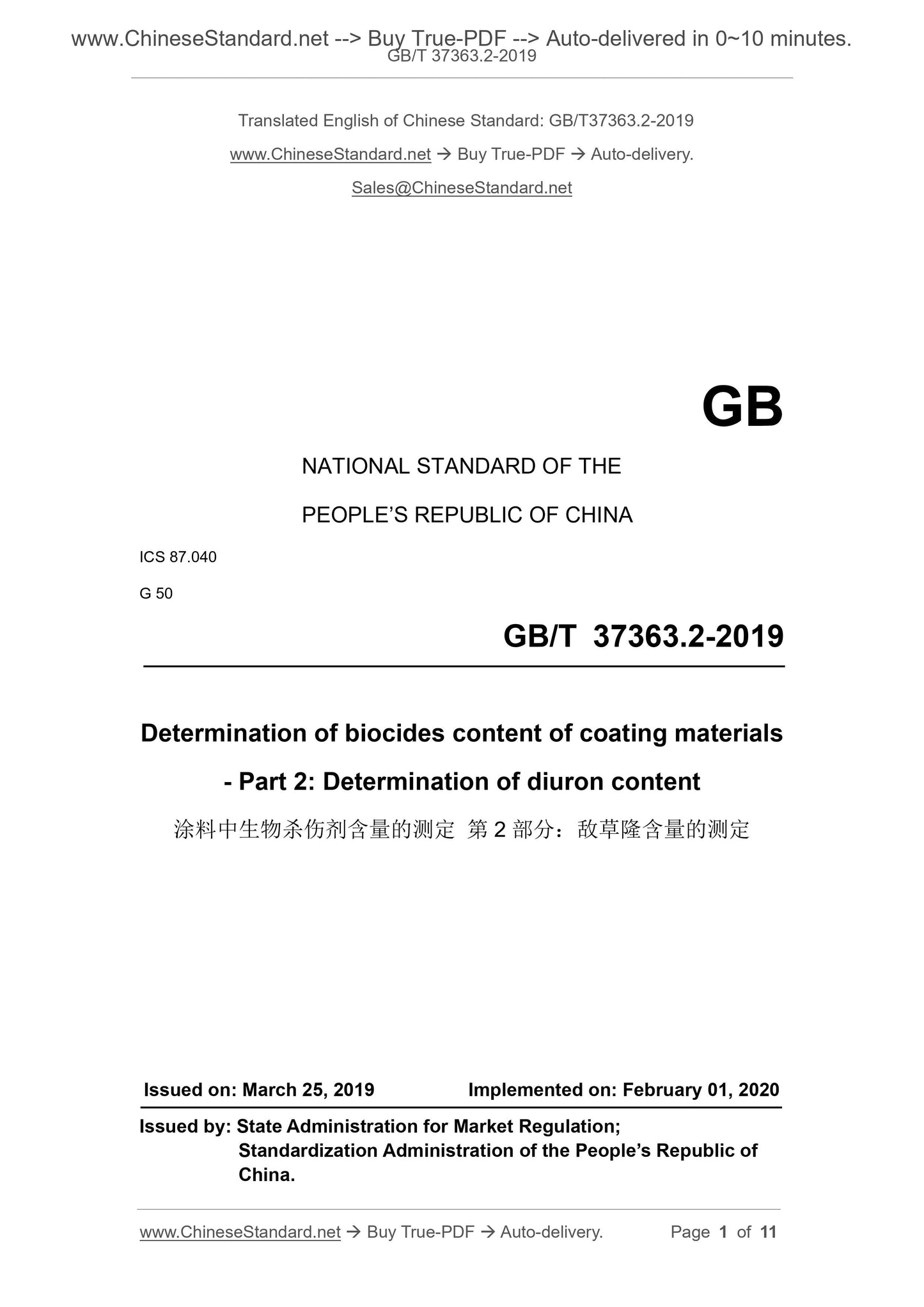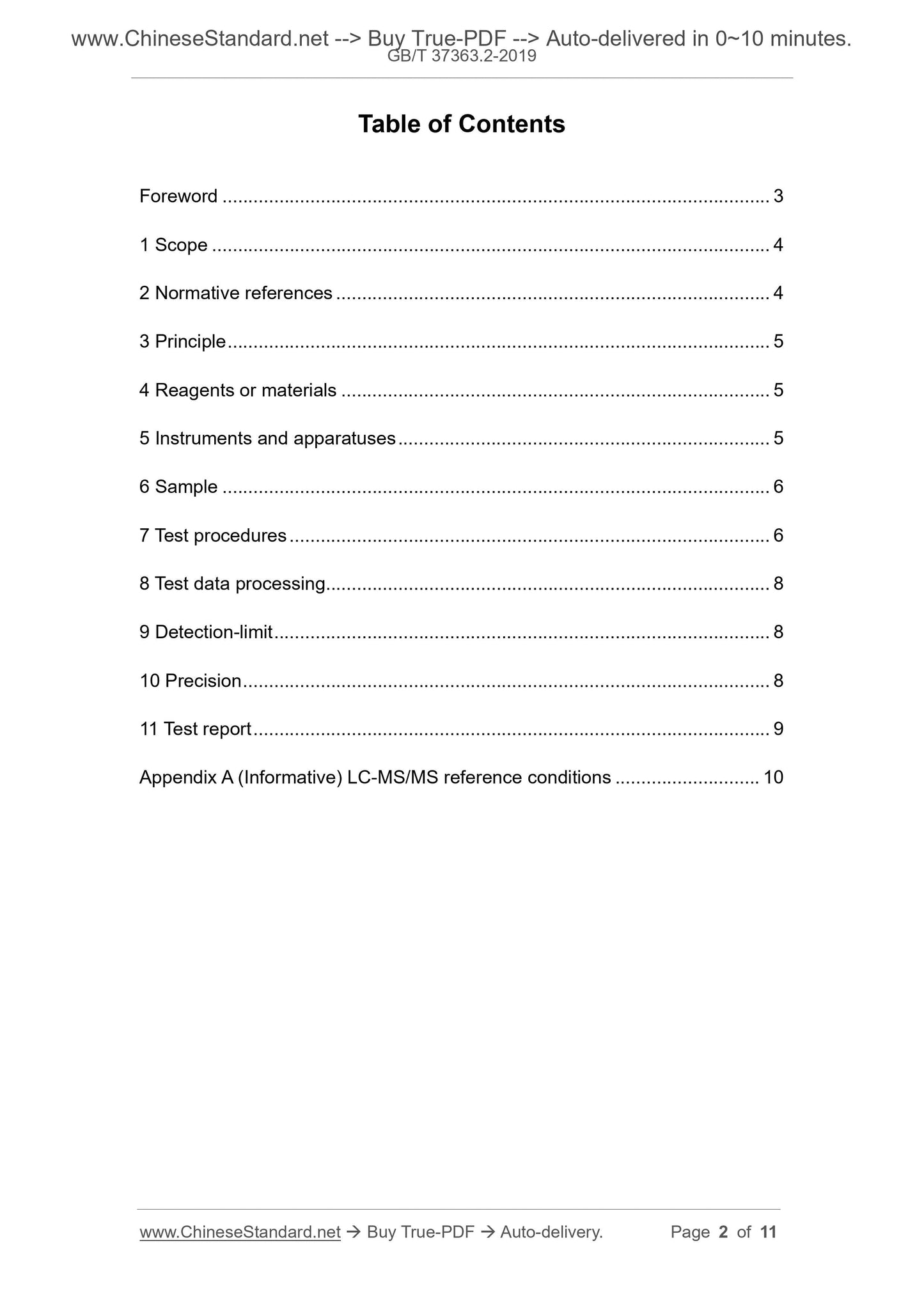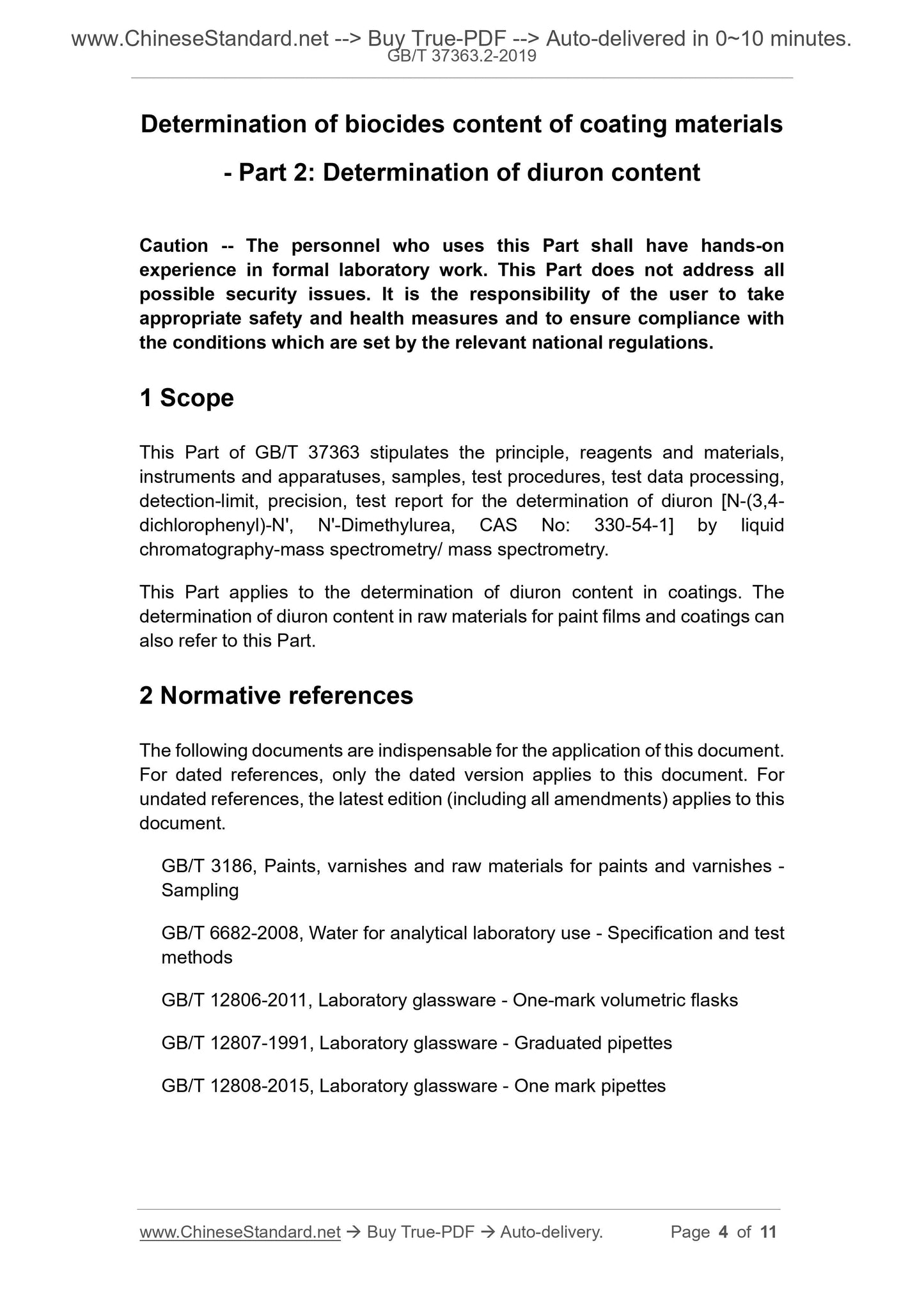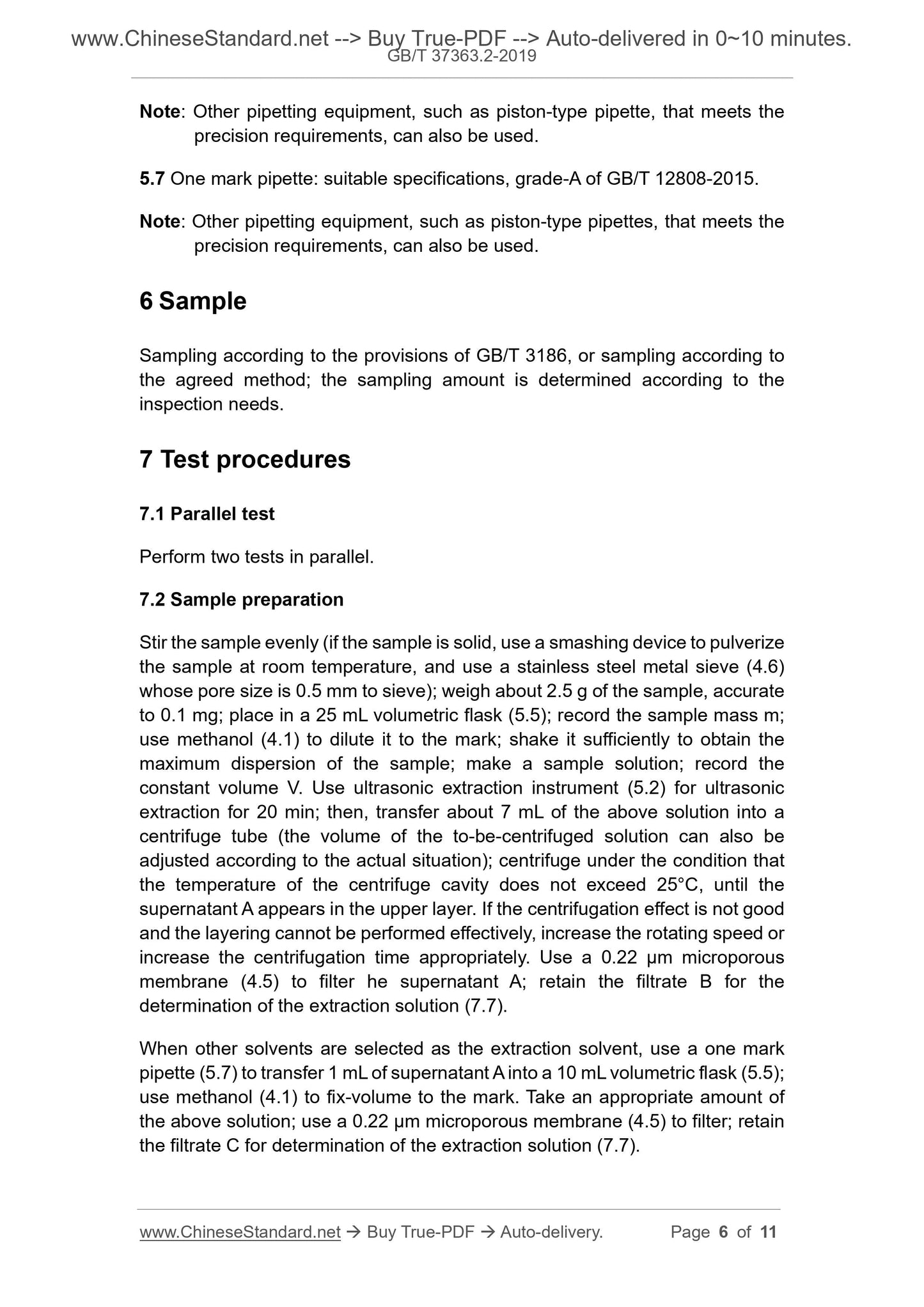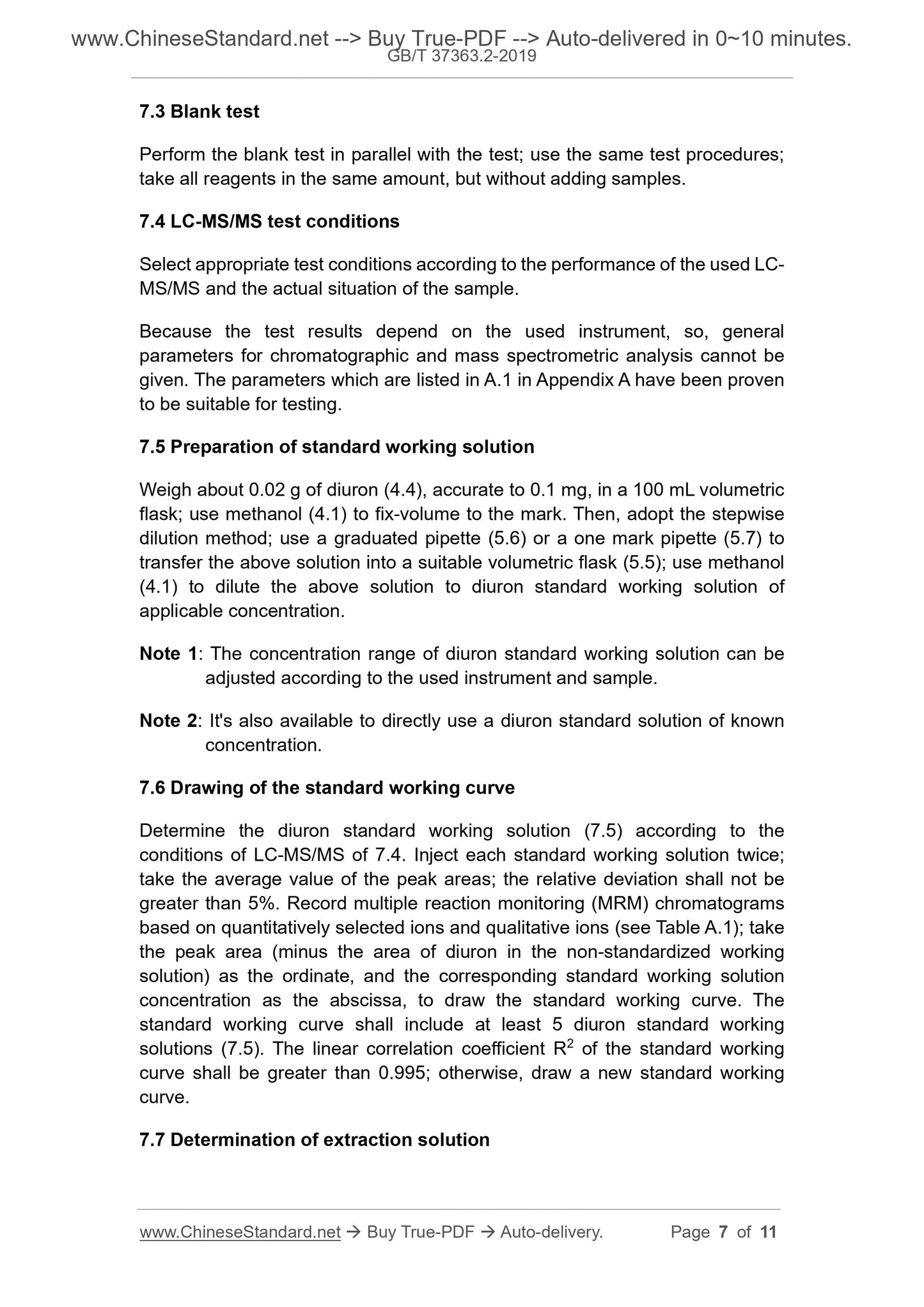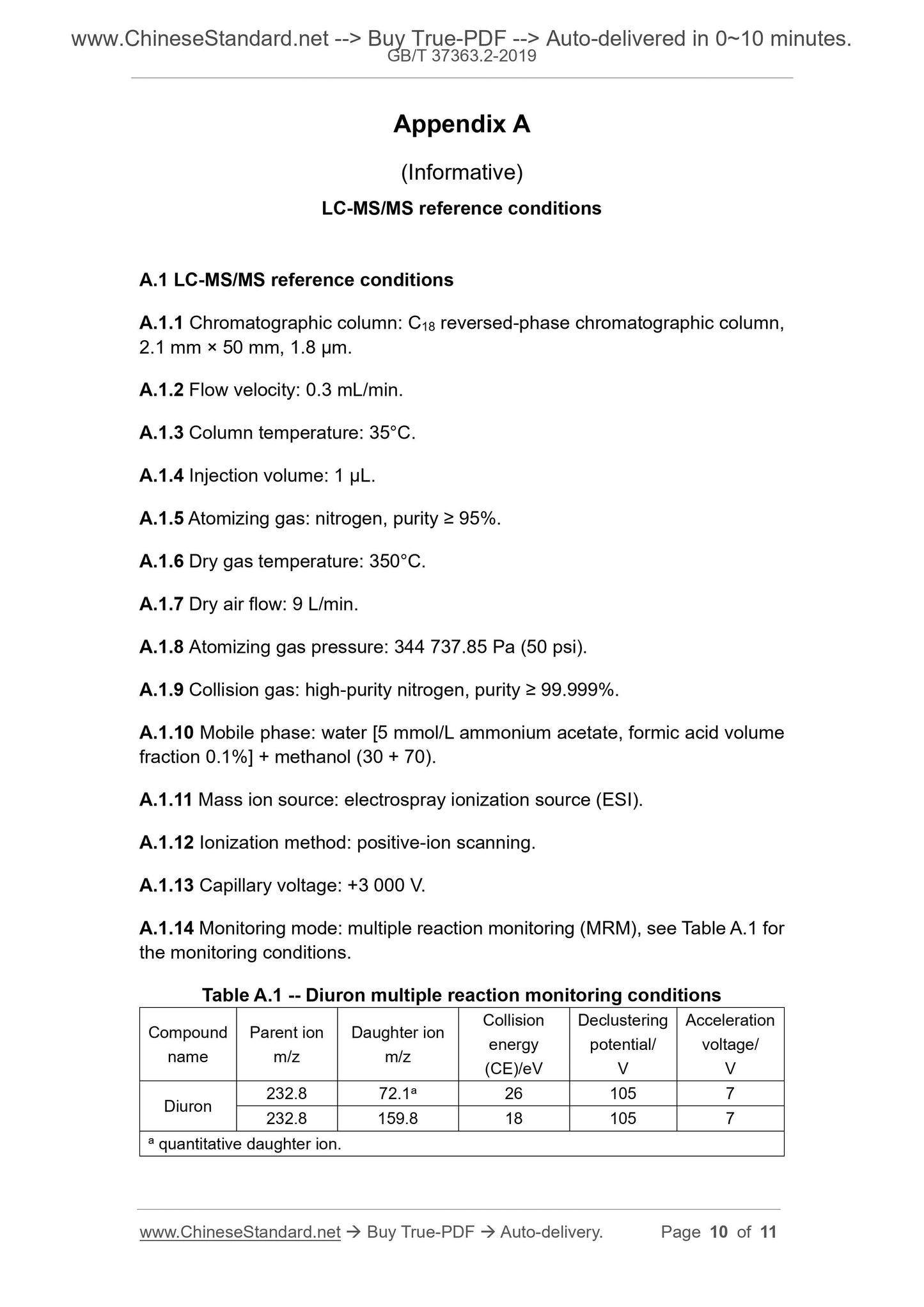1
/
of
6
PayPal, credit cards. Download editable-PDF & invoice In 1 second!
GB/T 37363.2-2019 English PDF (GB/T37363.2-2019)
GB/T 37363.2-2019 English PDF (GB/T37363.2-2019)
Regular price
$130.00 USD
Regular price
Sale price
$130.00 USD
Unit price
/
per
Shipping calculated at checkout.
Couldn't load pickup availability
Delivery: 3 seconds. Download true-PDF + Invoice.
Get QUOTATION in 1-minute: Click GB/T 37363.2-2019
Historical versions: GB/T 37363.2-2019
Preview True-PDF (Reload/Scroll if blank)
GB/T 37363.2-2019: Determination of biocides content of coating materials -- Part 2: Determination of diuron content
GB/T 37363.2-2019
NATIONAL STANDARD OF THE
PEOPLE’S REPUBLIC OF CHINA
ICS 87.040
G 50
Determination of biocides content of coating materials
- Part 2: Determination of diuron content
ISSUED ON: MARCH 25, 2019
IMPLEMENTED ON: FEBRUARY 01, 2020
Issued by: State Administration for Market Regulation;
Standardization Administration of the People’s Republic of
China.
Table of Contents
Foreword ... 3
1 Scope ... 4
2 Normative references ... 4
3 Principle ... 5
4 Reagents or materials ... 5
5 Instruments and apparatuses ... 5
6 Sample ... 6
7 Test procedures ... 6
8 Test data processing ... 8
9 Detection-limit ... 8
10 Precision ... 8
11 Test report ... 9
Appendix A (Informative) LC-MS/MS reference conditions ... 10
Determination of biocides content of coating materials
- Part 2: Determination of diuron content
Caution -- The personnel who uses this Part shall have hands-on
experience in formal laboratory work. This Part does not address all
possible security issues. It is the responsibility of the user to take
appropriate safety and health measures and to ensure compliance with
the conditions which are set by the relevant national regulations.
1 Scope
This Part of GB/T 37363 stipulates the principle, reagents and materials,
instruments and apparatuses, samples, test procedures, test data processing,
detection-limit, precision, test report for the determination of diuron [N-(3,4-
dichlorophenyl)-N', N'-Dimethylurea, CAS No: 330-54-1] by liquid
chromatography-mass spectrometry/ mass spectrometry.
This Part applies to the determination of diuron content in coatings. The
determination of diuron content in raw materials for paint films and coatings can
also refer to this Part.
2 Normative references
The following documents are indispensable for the application of this document.
For dated references, only the dated version applies to this document. For
undated references, the latest edition (including all amendments) applies to this
document.
GB/T 3186, Paints, varnishes and raw materials for paints and varnishes -
Sampling
GB/T 6682-2008, Water for analytical laboratory use - Specification and test
methods
GB/T 12806-2011, Laboratory glassware - One-mark volumetric flasks
GB/T 12807-1991, Laboratory glassware - Graduated pipettes
GB/T 12808-2015, Laboratory glassware - One mark pipettes
Note: Other pipetting equipment, such as piston-type pipette, that meets the
precision requirements, can also be used.
5.7 One mark pipette: suitable specifications, grade-A of GB/T 12808-2015.
Note: Other pipetting equipment, such as piston-type pipettes, that meets the
precision requirements, can also be used.
6 Sample
Sampling according to the provisions of GB/T 3186, or sampling according to
the agreed method; the sampling amount is determined according to the
inspection needs.
7 Test procedures
7.1 Parallel test
Perform two tests in parallel.
7.2 Sample preparation
Stir the sample evenly (if the sample is solid, use a smashing device to pulverize
the sample at room temperature, and use a stainless steel metal sieve (4.6)
whose pore size is 0.5 mm to sieve); weigh about 2.5 g of the sample, accurate
to 0.1 mg; place in a 25 mL volumetric flask (5.5); record the sample mass m;
use methanol (4.1) to dilute it to the mark; shake it sufficiently to obtain the
maximum dispersion of the sample; make a sample solution; record the
constant volume V. Use ultrasonic extraction instrument (5.2) for ultrasonic
extraction for 20 min; then, transfer about 7 mL of the above solution into a
centrifuge tube (the volume of the to-be-centrifuged solution can also be
adjusted according to the actual situation); centrifuge under the condition that
the temperature of the centrifuge cavity does not exceed 25°C, until the
supernatant A appears in the upper layer. If the centrifugation effect is not good
and the layering cannot be performed effectively, increase the rotating speed or
increase the centrifugation time appropriately. Use a 0.22 μm microporous
membrane (4.5) to filter he supernatant A; retain the filtrate B for the
determination of the extraction solution (7.7).
When other solvents are selected as the extraction solvent, use a one mark
pipette (5.7) to transfer 1 mL of supernatant A into a 10 mL volumetric flask (5.5);
use methanol (4.1) to fix-volume to the mark. Take an appropriate amount of
the above solution; use a 0.22 μm microporous membrane (4.5) to filter; retain
the filtrate C for determination of the extraction solution (7.7).
7.3 Blank test
Perform the blank test in parallel with the test; use the same test procedures;
take all reagents in the same amount, but without adding samples.
7.4 LC-MS/MS test conditions
Select appropriate test conditions according to the performance of the used LC-
MS/MS and the actual situation of the sample.
Because the test results depend on the used instrument, so, general
parameters for chromatographic and mass spectrometric analysis cannot be
given. The parameters which are listed in A.1 in Appendix A have been proven
to be suitable for testing.
7.5 Preparation of standard working solution
Weigh about 0.02 g of diuron (4.4), accurate to 0.1 mg, in a 100 mL volumetric
flask; use methanol (4.1) to fix-volume to the mark. Then, adopt the stepwise
dilution method; use a graduated pipette (5.6) or a one mark pipette (5.7) to
transfer the above solution into a suitable volumetric flask (5.5); use methanol
(4.1) to dilute the above solution to diuron standard working solution of
applicable concentration.
Note 1: The concentration range of diuron standard working solution can be
adjusted according to the used instrument and sample.
Note 2: It's also available to directly use a diuron standard solution of known
concentration.
7.6 Drawing of the standard working curve
Determine the diuron standard working solution (7.5) according to the
conditions of LC-MS/MS of 7.4. Inject each standard working solution twice;
take the average value of the peak areas; the relative deviation shall not be
greater than 5%. Record multiple reaction monitoring (MRM) chromatograms
based on quantitatively selected ions and qualitative ions (see Table A.1); take
the peak area (minus the area of diuron in the non-standardized working
solution) as the ordinate, and the corresponding standard working solution
concentration as the abscissa, to draw the standard working curve. The
standard working curve shall include at least 5 diuron standard working
solutions (7.5). The linear correlation coefficient R2 of the standard working
curve shall be greater than 0.995; otherwise, draw a new standard working
curve.
7.7 Determination of extraction solution
Appendix A
(Informative)
LC-MS/MS reference conditions
A.1 LC-MS/MS reference conditions
A.1.1 Chromatographic column: C18 reversed-phase chromatographic column,
2.1 mm × 50 mm, 1.8 μm.
A.1.2 Flow velocity: 0.3 mL/min.
A.1.3 Column temperature: 35°C.
A.1.4 Injection volume: 1 μL.
A.1.5 Atomizing gas: nitrogen, purity ≥ 95%.
A.1.6 Dry gas temperature: 350°C.
A.1.7 Dry air flow: 9 L/min.
A.1.8 Atomizing gas pressure: 344 737.85 Pa (50 psi).
A.1.9 Collision gas: high-purity nitrogen, purity ≥ 99.999%.
A.1.10 Mobile phase: water [5 mmol/L ammonium acetate, formic acid volume
fraction 0.1%] + methanol (30 + 70).
A.1.11 Mass ion source: electrospr...
Get QUOTATION in 1-minute: Click GB/T 37363.2-2019
Historical versions: GB/T 37363.2-2019
Preview True-PDF (Reload/Scroll if blank)
GB/T 37363.2-2019: Determination of biocides content of coating materials -- Part 2: Determination of diuron content
GB/T 37363.2-2019
NATIONAL STANDARD OF THE
PEOPLE’S REPUBLIC OF CHINA
ICS 87.040
G 50
Determination of biocides content of coating materials
- Part 2: Determination of diuron content
ISSUED ON: MARCH 25, 2019
IMPLEMENTED ON: FEBRUARY 01, 2020
Issued by: State Administration for Market Regulation;
Standardization Administration of the People’s Republic of
China.
Table of Contents
Foreword ... 3
1 Scope ... 4
2 Normative references ... 4
3 Principle ... 5
4 Reagents or materials ... 5
5 Instruments and apparatuses ... 5
6 Sample ... 6
7 Test procedures ... 6
8 Test data processing ... 8
9 Detection-limit ... 8
10 Precision ... 8
11 Test report ... 9
Appendix A (Informative) LC-MS/MS reference conditions ... 10
Determination of biocides content of coating materials
- Part 2: Determination of diuron content
Caution -- The personnel who uses this Part shall have hands-on
experience in formal laboratory work. This Part does not address all
possible security issues. It is the responsibility of the user to take
appropriate safety and health measures and to ensure compliance with
the conditions which are set by the relevant national regulations.
1 Scope
This Part of GB/T 37363 stipulates the principle, reagents and materials,
instruments and apparatuses, samples, test procedures, test data processing,
detection-limit, precision, test report for the determination of diuron [N-(3,4-
dichlorophenyl)-N', N'-Dimethylurea, CAS No: 330-54-1] by liquid
chromatography-mass spectrometry/ mass spectrometry.
This Part applies to the determination of diuron content in coatings. The
determination of diuron content in raw materials for paint films and coatings can
also refer to this Part.
2 Normative references
The following documents are indispensable for the application of this document.
For dated references, only the dated version applies to this document. For
undated references, the latest edition (including all amendments) applies to this
document.
GB/T 3186, Paints, varnishes and raw materials for paints and varnishes -
Sampling
GB/T 6682-2008, Water for analytical laboratory use - Specification and test
methods
GB/T 12806-2011, Laboratory glassware - One-mark volumetric flasks
GB/T 12807-1991, Laboratory glassware - Graduated pipettes
GB/T 12808-2015, Laboratory glassware - One mark pipettes
Note: Other pipetting equipment, such as piston-type pipette, that meets the
precision requirements, can also be used.
5.7 One mark pipette: suitable specifications, grade-A of GB/T 12808-2015.
Note: Other pipetting equipment, such as piston-type pipettes, that meets the
precision requirements, can also be used.
6 Sample
Sampling according to the provisions of GB/T 3186, or sampling according to
the agreed method; the sampling amount is determined according to the
inspection needs.
7 Test procedures
7.1 Parallel test
Perform two tests in parallel.
7.2 Sample preparation
Stir the sample evenly (if the sample is solid, use a smashing device to pulverize
the sample at room temperature, and use a stainless steel metal sieve (4.6)
whose pore size is 0.5 mm to sieve); weigh about 2.5 g of the sample, accurate
to 0.1 mg; place in a 25 mL volumetric flask (5.5); record the sample mass m;
use methanol (4.1) to dilute it to the mark; shake it sufficiently to obtain the
maximum dispersion of the sample; make a sample solution; record the
constant volume V. Use ultrasonic extraction instrument (5.2) for ultrasonic
extraction for 20 min; then, transfer about 7 mL of the above solution into a
centrifuge tube (the volume of the to-be-centrifuged solution can also be
adjusted according to the actual situation); centrifuge under the condition that
the temperature of the centrifuge cavity does not exceed 25°C, until the
supernatant A appears in the upper layer. If the centrifugation effect is not good
and the layering cannot be performed effectively, increase the rotating speed or
increase the centrifugation time appropriately. Use a 0.22 μm microporous
membrane (4.5) to filter he supernatant A; retain the filtrate B for the
determination of the extraction solution (7.7).
When other solvents are selected as the extraction solvent, use a one mark
pipette (5.7) to transfer 1 mL of supernatant A into a 10 mL volumetric flask (5.5);
use methanol (4.1) to fix-volume to the mark. Take an appropriate amount of
the above solution; use a 0.22 μm microporous membrane (4.5) to filter; retain
the filtrate C for determination of the extraction solution (7.7).
7.3 Blank test
Perform the blank test in parallel with the test; use the same test procedures;
take all reagents in the same amount, but without adding samples.
7.4 LC-MS/MS test conditions
Select appropriate test conditions according to the performance of the used LC-
MS/MS and the actual situation of the sample.
Because the test results depend on the used instrument, so, general
parameters for chromatographic and mass spectrometric analysis cannot be
given. The parameters which are listed in A.1 in Appendix A have been proven
to be suitable for testing.
7.5 Preparation of standard working solution
Weigh about 0.02 g of diuron (4.4), accurate to 0.1 mg, in a 100 mL volumetric
flask; use methanol (4.1) to fix-volume to the mark. Then, adopt the stepwise
dilution method; use a graduated pipette (5.6) or a one mark pipette (5.7) to
transfer the above solution into a suitable volumetric flask (5.5); use methanol
(4.1) to dilute the above solution to diuron standard working solution of
applicable concentration.
Note 1: The concentration range of diuron standard working solution can be
adjusted according to the used instrument and sample.
Note 2: It's also available to directly use a diuron standard solution of known
concentration.
7.6 Drawing of the standard working curve
Determine the diuron standard working solution (7.5) according to the
conditions of LC-MS/MS of 7.4. Inject each standard working solution twice;
take the average value of the peak areas; the relative deviation shall not be
greater than 5%. Record multiple reaction monitoring (MRM) chromatograms
based on quantitatively selected ions and qualitative ions (see Table A.1); take
the peak area (minus the area of diuron in the non-standardized working
solution) as the ordinate, and the corresponding standard working solution
concentration as the abscissa, to draw the standard working curve. The
standard working curve shall include at least 5 diuron standard working
solutions (7.5). The linear correlation coefficient R2 of the standard working
curve shall be greater than 0.995; otherwise, draw a new standard working
curve.
7.7 Determination of extraction solution
Appendix A
(Informative)
LC-MS/MS reference conditions
A.1 LC-MS/MS reference conditions
A.1.1 Chromatographic column: C18 reversed-phase chromatographic column,
2.1 mm × 50 mm, 1.8 μm.
A.1.2 Flow velocity: 0.3 mL/min.
A.1.3 Column temperature: 35°C.
A.1.4 Injection volume: 1 μL.
A.1.5 Atomizing gas: nitrogen, purity ≥ 95%.
A.1.6 Dry gas temperature: 350°C.
A.1.7 Dry air flow: 9 L/min.
A.1.8 Atomizing gas pressure: 344 737.85 Pa (50 psi).
A.1.9 Collision gas: high-purity nitrogen, purity ≥ 99.999%.
A.1.10 Mobile phase: water [5 mmol/L ammonium acetate, formic acid volume
fraction 0.1%] + methanol (30 + 70).
A.1.11 Mass ion source: electrospr...
Share
